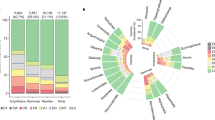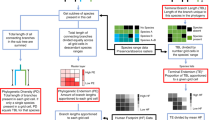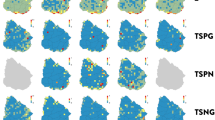Abstract
The distributions of amphibians, birds and mammals have underpinned global and local conservation priorities, and have been fundamental to our understanding of the determinants of global biodiversity. In contrast, the global distributions of reptiles, representing a third of terrestrial vertebrate diversity, have been unavailable. This prevented the incorporation of reptiles into conservation planning and biased our understanding of the underlying processes governing global vertebrate biodiversity. Here, we present and analyse the global distribution of 10,064 reptile species (99% of extant terrestrial species). We show that richness patterns of the other three tetrapod classes are good spatial surrogates for species richness of all reptiles combined and of snakes, but characterize diversity patterns of lizards and turtles poorly. Hotspots of total and endemic lizard richness overlap very little with those of other taxa. Moreover, existing protected areas, sites of biodiversity significance and global conservation schemes represent birds and mammals better than reptiles. We show that additional conservation actions are needed to effectively protect reptiles, particularly lizards and turtles. Adding reptile knowledge to a global complementarity conservation priority scheme identifies many locations that consequently become important. Notably, investing resources in some of the world’s arid, grassland and savannah habitats might be necessary to represent all terrestrial vertebrates efficiently.
This is a preview of subscription content, access via your institution
Access options
Access Nature and 54 other Nature Portfolio journals
Get Nature+, our best-value online-access subscription
$29.99 / 30 days
cancel any time
Subscribe to this journal
Receive 12 digital issues and online access to articles
$119.00 per year
only $9.92 per issue
Buy this article
- Purchase on Springer Link
- Instant access to full article PDF
Prices may be subject to local taxes which are calculated during checkout




Similar content being viewed by others
Change history
05 December 2017
In the version of this Article originally published, grant no. 2015/20215-7 for C.N. was omitted from the Acknowledgements section. This has now been corrected in all versions of the Article.
18 October 2017
In this Article originally published, owing to a technical error, the author ‘Laurent Chirio’ was mistakenly designated as a corresponding author in the HTML version, the PDF was correct. This error has now been corrected in the HTML version. Further, in Supplementary Table 3, the authors misspelt the surname of ‘Danny Meirte’; this file has now been replaced.
References
Grenyer, R. et al. Global distribution and conservation of rare and threatened vertebrates. Nature 444, 93–96 (2006).
Orme, C. D. L. et al. Global hotspots of species richness are not congruent with endemism or threat. Nature 436, 1016–1019 (2005).
Stuart, S. N. et al. Status and trends of amphibian declines and extinctions worldwide. Science 306, 1783–1786 (2004).
Brooks, T. M. et al. Global biodiversity conservation priorities. Science 313, 58–61 (2006).
Kremen, C. et al. Aligning conservation priorities across taxa in Madagascar with high-resolution planning tools. Science 320, 222–226 (2008).
Wilson, K. A., McBride, M. F., Bode, M. & Possingham, H. P. Prioritizing global conservation efforts. Nature 440, 337–340 (2006).
Holt, B. G. et al. An update of Wallace’s zoogeographic regions of the world. Science 339, 74–78 (2013).
Schipper, J. et al. The status of the world’s land and marine mammals: diversity, threat, and knowledge. Science 322, 225–230 (2008).
Bates, S. T. et al. Examining the global distribution of dominant archaeal populations in soil. ISME J. 5, 908–917 (2011).
Morueta-Holme, N. et al. Habitat area and climate stability determine geographical variation in plant species range sizes. Ecol. Lett. 16, 1446–1454 (2013).
Stuart-Smith, R. D. et al. Integrating abundance and functional traits reveals new global hotspots of fish diversity. Nature 501, 539–542 (2013).
Tittensor, D. P. et al. Global patterns and predictors of marine biodiversity across taxa. Nature 466, 1098–1101 (2010).
Mittermeier, R. A. et al. Hotspots Revisited: Earth’s Biologically Richest and Most Endangered Ecoregions (CEMEX, Mexico City, 2004).
Olson, D. M. & Dinerstein, E. The Global 200: a representation approach to conserving the Earth’s most biologically valuable ecoregions. Conserv. Biol. 12, 502–515 (1998).
Important Bird and Biodiversity Area (IBA) Digital Boundaries. Version 2015 2 (BirdLife Intranational, Cambridge, 2015).
Jetz, W. & Rahbek, C. Geographic range size and determinants of avian species richness. Science 297, 1548–1551 (2002).
Lennon, J. J., Koleff, P., Greenwood, J. J. D. & Gaston, K. J. Contribution of rarity and commonness to patterns of species richness. Ecol. Lett. 7, 81–87 (2004).
Joppa, L. N., Visconti, P., Jenkins, C. N. & Pimm, S. L. Achieving the Convention on Biological Diversity’s goals for plant conservation. Science 341, 1100–1103 (2013).
Naidoo, R. & Iwamura, T. Global-scale mapping of economic benefits from agricultural lands: implications for conservation priorities. Biol. Conserv. 140, 40–49 (2007).
Moilanen, A. et al. Prioritizing multiple-use landscapes for conservation: methods for large multi-species planning problems. Proc. R. Soc. Lond. B 272, 1885–1891 (2005).
Pianka, E. R. in Lacertids of the Mediterranean Region (eds Valakos, E. D., Böhme, W., Pérez-Mellado, V. & Maragou, P.) 121–154 (Hellenic Zoological Society, University of Athens, Athens, 1993).
Lewin, A. et al. Patterns of species richness, endemism and environmental gradients of African reptiles. J. Biogeogr. 43, 2380–2390 (2016).
Powney, G. D., Grenyer, R., Orme, C. D. L., Owens, I. P. F. & Meiri, S. Hot, dry and different: Australian lizard richness is unlike that of mammals, amphibians and birds. Glob. Ecol. Biogeogr. 19, 386–396 (2010).
Böhm, M. et al. The conservation status of the world’s reptiles. Biol. Conserv. 157, 372–385 (2013).
Meiri, S. & Chapple, D. G. Biases in the current knowledge of threat status in lizards, and bridging the ‘assessment gap’. Biol. Conserv. 2014A, 6–15 (2016).
Roll, U. et al. Using Wikipedia page views to explore the cultural importance of global reptiles. Biol. Conserv. 204A, 42–50 (2016).
Bode, M. et al. Cost-effective global conservation spending is robust to taxonomic group. Proc. Natl Acad. Sci. USA 105, 6498–6501 (2008).
Hawkins, B. A. et al. Energy, water, and broad-scale geographic patterns of species richness. Ecology 84, 3105–3117 (2003).
Uetz, P. & Hošek, J. The Reptile Database (2015); http://www.reptile-database.org/
Pouzols, F. M. et al. Global protected area expansion is compromised by projected land-use and parochialism. Nature 516, 383–386 (2014).
Scott, J. M. et al. Gap analysis: a geographic approach to protection of biological diversity. Wildlife Monogr. 123, 3–41 (1993).
Maldonado, C. et al. Estimating species diversity and distribution in the era of Big Data: to what extent can we trust public databases? Glob. Ecol. Biogeogr. 24, 973–984 (2015).
Maréchaux, I., Rodrigues, A. S. L. & Charpentier, A. The value of coarse species range maps to inform local biodiversity conservation in a global context. Ecography https://doi.org/10.1111/ecog.02598 (2016).
Cantú-Salazar, L. & Gaston, K. J. Species richness and representation in protected areas of the Western Hemisphere: discrepancies between checklists and range maps. Divers. Distrib. 19, 782–793 (2013).
Anselin, L. Local indicators of spatial association — LISA. Geogr. Anal. 27, 93–115 (1995).
Acknowledgements
We thank T. Burbidge, T. Dowe, S. Huang, S. Khela, H.-Y. Lee, K. Tamar, J. Usherwood, M. Hopkins and S. Halle for help in digitizing reptile ranges. We thank librarians and colleagues for help in obtaining relevant literature, G. Bunting and M. Balman for providing IBA polygons and bird species distribution maps from BirdLife International, as well as S. Butchart for insightful comments. A.B. thanks the Gerald M. Lemole endowed Chair funds. G.R.C. thanks CAPES - Coordenação de Aperfeiçoamento de Pessoal de Nível Superior, Conselho Nacional de Desenvolvimento Científico e Tecnológico – CNPq and Fundação de Apoio à Pesquisa do Distrito Federal – FAPDF for financial support. I.D. was supported by a Niche Research Grant Scheme, NRGS/1087/2–13(01). C.N. and M.M. were supported by São Paulo Research Foundation (FAPESP no. 2011/50206-9, no. 2012/19858-2 and no. 2015/20215-7 to C.N.). M.M. acknowledges a research fellowship from CNPq. O.T.C. acknowledges support from SENESCYT. R.G. acknowledges the John Fell Fund of the University of Oxford for support. A.A. and S.M. acknowledge support from a BSF grant no. 2012143.
Author information
Authors and Affiliations
Contributions
A.M.B., R.G., S.M., U.R. conceived the study. R.G., C.D.L.O., U.R. designed the analyses. U.R. conducted the analyses. A.F., S.M., M.N., U.R. complied, designed and curated the dataset. R.G., S.M., U.R. wrote the paper. A.A., A.M.B., M.B., R.B., B.C., F.C.H., L.C., G.R.C., L.D., I.D., T.M.D., A.F., L.L.G., M.H., Y.I., F.K., A.L., M.L., E.M., D.M., M.M., S.M., C.C.N., M.N., Z.T.N., G.P., O.S.G.P., D.P.D., U.R., R.S., O.J.S.T., O.T.C., J.F.T., E.V., P.U., P.W., Y.W. provided, collated and verified underlying data. All authors read and commented on the manuscript.
Corresponding author
Ethics declarations
Competing interests
The authors declare no competing financial interests.
Additional information
Publisher’s note: Springer Nature remains neutral with regard to jurisdictional claims in published maps and institutional affiliations.
Electronic supplementary material
Supplementary Information
Supplementary Methods, Supplementary Tables 1–4, Supplementary Figures 1–8, Supplementary References and descriptions of Supplementary Tables 3–4
Supplementary Table 3
Full list of sources per species and details for each source.
Supplementary Table 4
List of species found in the March 2015 version of the Reptile Database (http://www.reptile-database.org/data/reptile_checklist_2015_03.xls.zip) for which we did not present or analyse distributions.
Rights and permissions
About this article
Cite this article
Roll, U., Feldman, A., Novosolov, M. et al. The global distribution of tetrapods reveals a need for targeted reptile conservation. Nat Ecol Evol 1, 1677–1682 (2017). https://doi.org/10.1038/s41559-017-0332-2
Received:
Accepted:
Published:
Issue Date:
DOI: https://doi.org/10.1038/s41559-017-0332-2
This article is cited by
-
Assessing Brazilian turtles’ vulnerability BY USING species distribution models AND dispersal constraints
Biodiversity and Conservation (2024)
-
Does the expensive brain hypothesis apply to amphibians and reptiles?
BMC Ecology and Evolution (2023)
-
The geography of climate and the global patterns of species diversity
Nature (2023)
-
A telemetry study shows that an endangered nocturnal avian species roosts in extremely dry habitats to avoid predation
Scientific Reports (2023)
-
Abrupt expansion of climate change risks for species globally
Nature Ecology & Evolution (2023)



